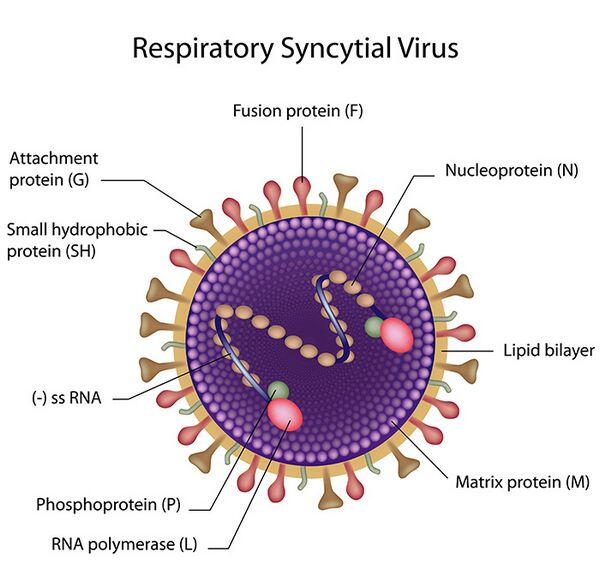Description of Medical Condition
RSV causes respiratory illness
- Adults: URI’s
- Infants and children: bronchitis, bronchiolitis, pneumonia
- Leading cause of pediatric admissions for respiratory illness
System(s) affected: Pulmonary
Genetics: None known
Incidence/Prevalence in USA: Common in winter. Almost all persons infected one or more times during lifetime.
Predominant age: Birth to age 2
Predominant sex:
- Males = females as outpatients
- 2:1 males/females in hospital

Medical Symptoms and Signs of Disease
Cold signs and symptoms (mild disease)
- Fever
- Cough
- Coryza
- Congestion
- Otitis media
- Malaise
Bronchitis/bronchiolitis/pneumonia
- Cough
- Chest congestion, rales/rhonchi
- Wheezing
- Dyspnea
- Hypoxia
- Cyanosis
Vomiting
What Causes Disease?
Infection with RSV
Risk Factors
- Impaired immunity OAIDS
- Chemotherapy
- Other types of impaired immunity
- Occupational exposure
- Day care workers
- Pediatric hospital staff
- School teachers
- Neonatal/congenital conditions
- Congenital cardiac anomalies
- Respiratory distress syndrome
- Premature birth
- Low socioeconomic status
- More common in urban vs. rural areas
Diagnosis of Disease
Differential Diagnosis
- Mild illness/upper respiratory tract
- Colds (non RSV)
- Allergic rhinitis
- Sinusitis
- Croup
- Severe illness/lower respiratory tract
- Asthma
- Bronchitis
- Bronchiolitis
- Pneumonia
Laboratory
- WBC may be normal to elevated
- Positive RSV antigen test on nasal washings
Drugs that may alter lab results: None
Disorders that may alter lab results: None
Pathological Findings
Lymphocytic peribronchiolar infiltrates (autopsy)
Imaging
Chest x-ray
- Hyperinflation — most common, characteristic finding
- Interstitial infiltrates — fairly common
- Segmental or lobar consolidation in pneumonia
- Pleural fluid
Diagnostic Procedures
None
Treatment (Medical Therapy)
Appropriate Health Care
Outpatient for mild cases; inpatient for severe disease or for those with underlying disorders. Illness can last from days to several weeks.
General Measures
Outpatient
- Rest/supportive care
- Bronchodilators — albuterol nebulizer/inhaler
- Monitor oxygenation-pulse oximeter
Inpatient
- Oxygen
- Bronchodilators — albuterol nebulizer q4h
- Respiratory isolation ORibavirin
- Antibiotics for secondary bacterial pneumonia
- Monitor arterial blood gases/pulse oximeter
- Use of steroids is controversial; may help in some cases
Avoid exposing others
- Remove from day care/school until well
- Good hand washing practices
- Respiratory isolation in hospital
Activity
Decreased household activity/rest
Diet
- Maintain nutrition
- Avoid over-hydration (may increase lung congestion)
Medications (Drugs, Medicines)
Drug(s) of Choice
- Ribavirin 20 mg/mL mist 12-18 hours/day for 3-7 days. (Can shorten duration and severity of illness.)
- Bronchodilators — albuterol nebulizer q4h (dose appropriate for age)
- Antibiotics for secondary bacterial infections/pneumonia
- Appropriate to particular pathogen
- Prophylactic use of antibiotics controversial
- Potential use of RSV immune globulin in high risk infants
Contraindications: See specific drug related information
Precautions: Avoid exposure of pregnant/potentially pregnant women to ribavirin
Significant possible interactions: See specific drug information
Alternative Drugs
- Antibiotic appropriate to identified or suspected bacterial pathogen
- Theophylline use all right, but not recommended
Patient Monitoring
- Uneventful resolution is the norm
- No special monitoring is needed as illness resolves
- May want to educate parents about SIDS — avoid prone sleeping in infants
Prevention / Avoidance
- Avoid exposure to those ill with RSV
- Good hand washing practices (since hand-nose and hand-eye transmission is common)
- Avoid rubbing the eyes (common RSV inoculation route)
- Use of palivizumab (Synagis) recommended for pree-mies < 35 weeks and infants with bronchopulmonary dysplasia prior to and during RSV season (Fall, Winter, Spring). Dose 15 mg/kg of body weight IM monthly.
Possible Complications
- Pneumonia
- Sudden infant death
- Death from severe lower respiratory tract infections
- Possible residual lung damage
Expected Course / Prognosis
- Usually resolves within two weeks without sequelae
- Hospitalization rate of children ill with RSV varies from 1:50 to 1:200 (children < 2 years old)
Miscellaneous
Associated Conditions
- Asthma is worse with RSV and vice versa
- SIDS may be a sequelae of RSV
Age-Related Factors
Pediatric: Most common under age 2
Geriatric: N/A
Others: Increasing immunity with subsequent infections by RSV usually results in less serious illness
Pregnancy
- Avoid ribavirin therapy in pregnancy
- Healthcare workers who may be pregnant should avoid exposure to ribavirin
International Classification of Diseases
480.1 Pneumonia due to respiratory syncytial virus
See Also
Bronchiolitis Pneumonia, bacterial Pneumonia, viral Bronchitis, acute
Abbreviations
- RSV = respiratory syncytial virus
- SIDS = sudden infant death syndrome
- URI = upper respiratory infection



